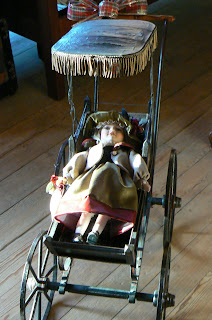Doll Carriage Hunter Dawson House by Tricia Grissom
Learning about photography as I go has been my m.o. when it comes to taking pictures for my freelance articles. I've discovered tons just by doing it.
Learning to drive a stick shift takes some clutch popping (so sorry, first car) and learning photography means pointing and shooting with the camera you'll be using. So I got to thinking - Why not make a trial run of a writing assignment before you actually get it?
I wish I had. I'd have learned more thoroughly how my camera works and what all those settings mean. It's easy to see mistakes after you get home and blow them up in living color.
So pretend you're doing a story on this festival or that museum. Before you go, look at how the magazine or publication you want to write for does their photos. What angles do they like? Are there a lot of close ups? I say mimic mercilessly to get good pictures.
When the trees go up in flames in the fall, it's a great time to get some photo practice. And I confess, I just love to snap photos. My latest of my daughter with her mouth open is my favorite. I'd post it here, but I like all my body parts where they are. Fifteen-year-old girls have no sense of humor about these things.

4 comments:
Great post! Practice not only works out great for newbie photographers, it also is great advice for experienced photographers. With the current crop of cameras, you can get some very good shots by shooting in the automatic mode. However, the value of practicing is that you also learn how to use more of the functions of your camera - other than the automatic mode.
Most experienced photographers are aware of this. One of the differences that distinguishes the experienced photographers that almost always shoot great shots, is their relentless practice (and familiarizing themselves with their camera controls).
Automatic is good. But, it does nothing to teach how to take good shots. Just like I assume good writing is, good photography requires intentional practice and practice to fully appriciate and learn the "tools of the trade."
Your suggestion that the practicing photographer try to shoot within the context of the publication that they want to accept their work, is right on the money. In fact, that is what "gets stock and freelance photographers paid!"
Hi Kalem,
Thank God for the new cameras. And thanks for the further insights.
You're a good mom! I'll just use my imagination...
Been thinking about jumping on this bandwagon.
Any tips for type of camera and how (what format) publishers prefer to receive submissions?
Post a Comment